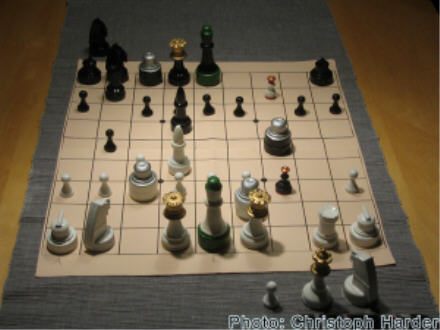Kasparov's Premiere at Shogi
Super Garry comes ominously close to humiliating a 3 dan-player of Shogi
By Dr. René Gralla, Hamburg, Germany
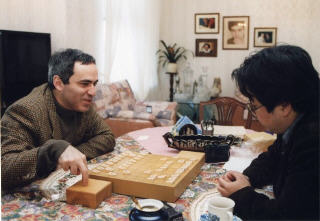
Parallel to these already time-consuming activities Kasparov has clandestinely tried to unravel the mysteries of Mental Martial Arts from Asia. Only now it has become known outside Japan that Kasparov has played a match of Shogi - that special version of chess from the Isles of Nippon - some years ago. Manabu Terao, Vice-Director of the "International Shogi Popularization Society" (ISPS), a non-profit non-governmental organization that works on promoting Shogi world-wide, relates that historic encounter from 1999 on the web site:
http://shogi.net/shogi-l/Archive/1999/Njul06-00.txtCourtesy to ISPS and Kyodo News, chessvariants.com has now managed to acquire the rights to publish those sensational photos that show Garry Kasparov over the board of Shogi. Manabu Terao tells us how the whole thing has started.
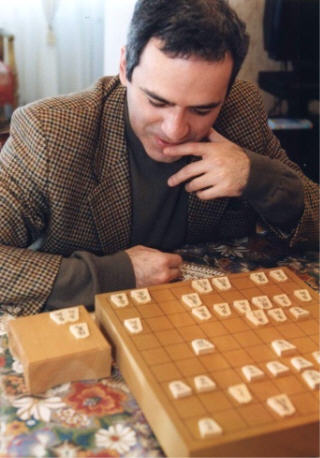
"Dear Shogi Fans, I read a very interesting story in the 'Shogi Sekai' (monthly magazine issued by 'Nihon Shogi Renmei', the Shogi Association of Japan). Eiichiro Ishiyama, a journalist working for the agency Kyodo News, has succeeded in having an interview with Garry Kasparov at his residence in the suburbs of Moscow. Ishiyama is also an amateur Shogi player with 3 dan strength. The main topic of the interview was about whether artificial intelligence could exceed human beings. Just before the pre-arranged interview time was over, Ishiyama put on the table a set of Shogi board with 3 centimeters height plus pieces which he had brought from Japan. Kasparov knew a little bit of Shogi, but until that day he did not know how to play exactly. Ishiyama taught Kasparov in what direction each piece can move and some more rules that are sufficient to enjoy the game. Then the game started. Kasparov gradually got serious and he continued the game until the end - in spite of his mother who gave the alarm several times that the arranged time was over. After the match Kasparov said, 'Shogi is a unique game. I will learn it more. I would like to go to Japan."
ISPS-Manabu Terao comments: "I do not know if this is just diplomacy, but I think
it is significant for such a top chess player as Kasparov to get familiar with Shogi
to encourage or motivate many chess-players to get interested in Shogi."
The German daily "Neues Deutschland" (ND) has published a feature about that historic encounter between East and West:
http://www.neues-deutschland.de/artikel/118989.html
The Rules of Shogi
How has Kasparov fared on the unknown terrain of Shogi? First let's have have a look at the special rules of Japanese Chess. Shogi is played on a 9 by 9 uncheckered board.
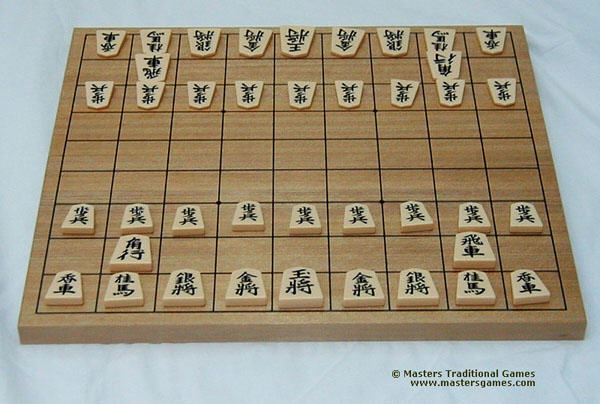
The original Japanese design of a board of Shogi. With a special feature: Since the Black party - Japanese: "Sente" - starts the match Black is positioned at the "lower" side of the theatre of operations, whereas White - Japanese: "Gote" - is positioned on the "upper" side; in FIDE chess it is vice versa.
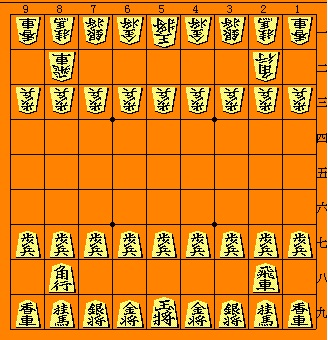
Therefore, after having transformed the original Japanese design into westernized optics, we find out that the initial battle order of Shogi is "topsyturvy" in comparison to FIDE-Chess.

Now we turn the diagram upside down - and, big surprise, Shogi does not look so strange anymore after that; last not least due to a catchy westernized design that has been produced and published by Douglas Crockford on his web page:
http://www.crockford.com/chess/shogi.html

The three rows of light-coloured squares at both ends of the board form the mutual promotion zones of White and Black (diagram: produced by Douglas Crockford).
The Pieces
We follow so far the explanations given to us by Douglas Crockford on his web pagehttp://www.crockford.com/chess/shogi.htmlIn order to make players of Western Chess feel more comfortable in the exotic scenario of Shogi the author has produced the prototype of a set of Shogi that is based on figurine pieces; that is a new approach to get familiar with Japanese Chess.

Innovative design of Shogi in westernized figurine style (photo: Christoph Harder). Outside the board the pieces of reserve: After one player has caught a piece of the adversary by a given move he trades in that piece into a piece of the reserve that bears the colours of his army; after that he can place that piece on the board again instead of executing the next move. After one player has managed to thrust one piece into the zone of promotion - rows 7 to 9 for White, rows 3 to 1 for Black - , then he can trade in that piece into its corresponding version of promoted piece, and he can instantly put that promoted piece back on the board in exchange for the piece that has just been be promoted (photo: Christoph Harder; design of figurine pieces: Dr. René Gralla).
In the following the units of the Army of Shogi.
The King - or Jade General (abbrev.: K ) - moves like the FIDE-Chess King: one square horizontally or vertically or diagonally. There is no castling.
The Gold General (abbrev.: G) has moves similar to the King, except that it cannot take the back diagonals.
The Silver General (abbrev.: S) has moves similar to the King, except that it cannot move horizontally or directly backwards. It can move one space diagonally or forward.
The Knight - or Honoured Horse (abbrev.: H) - jumps like the FIDE-Chess Knight, except that it can only go two spaces forward and one space horizontally either to the left or to the right. It cannot jump back or to the side.
The Lance - or Fragrant Chariot (abbrev.: L) - moves like the FIDE-Chess Rook, except that it can only move forward. It cannot move horizontally or backwards.
The Rook - or Flying Chariot (abbrev.: R) - moves like the FIDE-Chess Rook. It can go any number of spaces vertically or horizontally.
The Bishop - or Horned Chariot (abbrev.: B) - moves like the FIDE-Chess Bishop.
The Pawn (abbrev.: P) moves one space forward only. Unlike the Western Pawn in FIDE-Chess, the Shogi-Pawn does not capture diagonally; the Shogi-Pawn catches by striking forward. It does not have the option to go two steps on its first move. There is no en passant-capture.
Promotion
In FIDE-Chess, Pawns can be promoted. In Shogi, all pieces except the King and the Gold General can be promoted.Promotion can happen at the end of any move in which the piece enters, exits, or moves within the three-row promotion zone. Pawn and Lance must be promoted when reaching the 9th row, Knight must be promoted when reaching the 8th or 9th row.
The promoted Pawn - abbrev.: pr.P (abbrev. in traditional Shogi-literature: +P) , promoted Lance - pr.L (abbrev. in traditional Shogi-literature: +L) - , promoted Knight - pr.N (abbrev. in traditional Shogi-literature: +N) - and promoted Silver General - pr.S (abbrev. in traditional Shogi-literature: +S)- all have the moves of the Gold General.
The promoted Rook - pr.R (abbrev. in traditional Shogi-literature: +R) - becomes "Dragon King" (not to be mistaken for the King). It has the moves of the Rook and the King combined.
The promoted Bishop - pr.B (abbrev. in traditional Shogi-literature: +B) - becomes "Dragon Horse" (not to be mistaken for the Knight). It has the moves of the Bishop and the King combined.
Drops
The most distinctive feature is that captured pieces can be returned to play. Captured pieces change to the captor's colour, and those captured pieces can be placed on an empty square - another expression for that: "be dropped" - instead of moving a piece. Pieces are always dropped in their unpromoted state.Pawns, Lances and Knights cannot be dropped in the 9th row. Knights cannot be dropped in the 8th row.
You cannot drop a Pawn into a column (or file) that already contains one of your unpromoted Pawns.
A Pawn cannot be dropped to give checkmate, although a Pawn can be dropped to give check. Any other piece can be dropped to give checkmate.
Race against time
The foregoing briefing enables our readers to understand what is going on during the match of Shogi between Garry Kasparov and Eiichiro Ishiyama. The annotation is a westernized way of recording the moves; it is based on defining the verticals by letters a to i and on defining the laterals by numbers 1 to 9.If a piece is dropped on a given square - say: a Bishop is dropped on e5 - , the drop will be recorded as follows:
B-e5 drops.If a pieces enters the promotion zone and gets promoted - say: Black Bishop moves from h8 to a1 - , that move will be recorded as follows:
Bh8-a1 promotes.After the promotion the promoted piece - say: the Bishop after promotion - will be branded as follows:
pr.B.The effect of checking by executing a move will be made obvious by explicitly adding the word "check". In parenthesis the original Japanese way of recording moves has been added; that Japanese way is based on defining the verticals by numbers 1 to 9 and the laterals by letters a to i.
If a piece is dropped on a given square - say: the Bishop is dropped on 5e - , the original Shogi literature records the move as follows:
B*5e.If a pieces enters the promotion zone and gets promoted - say: Black Bishop moves from h8 to 1a - , the original Shogi literature records the move as follows:
Ba1+.Attention: that special mark "+" in traditional Shogi literature shall not be mistaken for a symbol of "check": Shogi literature does not explicitly record the eventual effect of checking by a given move! After the promotion the promoted piece - say: the Bishop after promotion - will be branded as follows:
+B.
Kasparov - Ishiyama
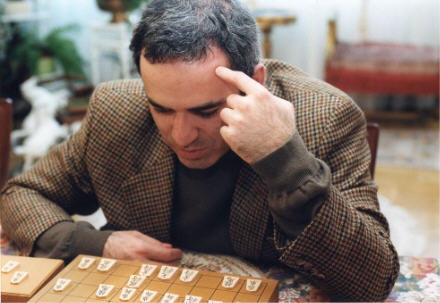 White: Kasparow, Garry (ELO 2851)
White: Kasparow, Garry (ELO 2851) Black: Ishiyama, Eiichiro (3.Dan)
March 1999, Moscow, residence of Garry Kasparov
In original Japanese optics - Black at the lower side and White at the upper side of the diagrams - that match can be replayed online:
http://www.shogi.de/games/shogiviewer_davin/kasparow_1st.htmlGenshi Sujichigai Kaku - Primitive Parallel Diagonal Bishop
1.... g7-g6 (1.P7f ...)
Remember: In Shogi Black has the right to start the game.
2.c3-c4 Bh8xb2 promotes ?!? (1.... P3d 2.Bx2b+ ?!? ...)
Usually that early exchange will be avoided by players of Shogi. But Ishiyama exchanges the Bishop after having been asked by Kasparov to do so because Kasparov wants to study the effect of that move.
3.Sc1xb2 b7-b6 4.g3-g4 b6-b5 (2.... Sx2b 3.P2f P7d 4.P2e ...)
Ishiyama menaces the early bumping into b3 (2c) by 5....b4 (5.P2d ...).
5.Sb2-c3 ... (4.... S3c)
That prevents 5....b4 (5.P2d ...).
5.... Gf9-g8 6.Nh1-g3 Sg9-h8 7.h3-h4 Sh8-g7 8.h4-h5 B-d6 drops! (5.G7h N7c 6.S8 h P8d 7.S7g P8e 8.B*4f ! ...)
Black Bishop pins White Ng3 (N7c) - since White Rh2 (R8b) is diagonally positioned behind Ng3 (N7c).
9.Sg1-f2 Sg7-f6 10.h5-h6 ... (8.... S6b 9.S6f P8f)
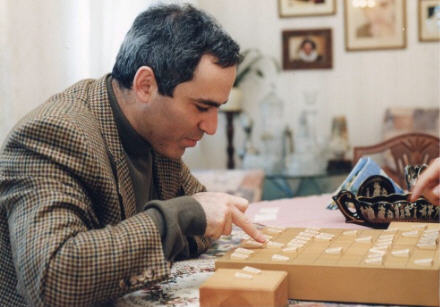
That's the way we know Kasparov: He seeks the early confrontation - even on the fairly unknown territory of Shogi.
10.... h7xh6 11.Rh2xh6 P-h7 drops! (10.Px8f Rx8f 11.P*8g ! ...)
The drop of that Black Pawn seals off vertical h (vertical 8) - and attacks White Rook.
12.Rh6-h1! ... (11. ... R8a!)
Kasparov does not walk into the trap of eating Black Pawn g6 (P7f) that is full of poison: 12.Rxg6?? Gg7! (11. ... Rx7f?? 12.G7g ...), and White Rook gets lost.
12. ... Nh9-g7 13.B-d4 drops g6-g5 14.g4xg5 Sf6xg5 15.P-g6 drops! ... (12.N7g B*4d 13.P7e Px7e 14.Sx7e P*7f)
That "tesuji" - Japanese: "clever move" - by Kasparov, the novice of Shogi - attacks Black Knight that cannot avoid that thrust.
15.... P-g4 drops! (15.P*7d ! ... )
In Shogi counter-attack is the best defence.
16.g6xg7 promotes g4xg3 promotes 17.pr.Pg7xg8 ... (15.... Px7g+ 16.Px7c+ +Px7h)
Now the race is on: Who will be the first to fight his way through to the King of the opponent?
Photo: Christoph Harder; design of figurine pieces: Dr. René Gralla.
17. ... pr.Pg3xf2 check 18.Gf1xf2 ... (17.+Px6b Gx6b)
At this very moment White has gained a material surplus: There are one Gold General, one Knight and two Pawns in Kasparov's reserve. In comparison to that Ishiyama has only conquered one Silver General and one Knight.
18.... b5-b4 (18.P2d ...)
Ishiyama is undisturbed: He attacks on the right wing.
19.Bd4xi9 promotes b4xb3 promotes 20.Rh1xh7 promotes ... (18.... Bx9i+ 19.Px2c+ Rx8g+)
Kasparov has managed to promote his Rook: Ishiyama's King can smell the smoke and fire that White Dragon King is spitting.
20.... pr.Pb3xc3! 21.Nb1xc3 Rb8-b1 promotes 22.G-f8 drops & check ... ( 20.+Px3c! Nx3c 21.R2a+ G*6h)

Ishiyama's Black King should get the jitters: Kasparov's task force of White Gold General f8 (6h) plus promoted White Pawn (Japanese: "tokin") is closing in, and White Dragon King h7 (8g) and White Dragon Horse i9 (9i) are eager to join the fight
(photo: Christoph Harder; design of figurine pieces: Dr. René Gralla).
22.... Ke9-d8 23.Gf2-e2 S-c2 drops! (22.K4h G6b-5b 23.S*3b ! ...)
That drop takes advantage of the pin of White Gold General d1 (G4a).
24.Ge2-d2 Sc2xd1 promotes & check 25.Gd2xd1 S-c2 drops! (23.... G5b-4b 24.Sx4a+ Gx4a 25.S*3b ! ...)
That is Shogi: The second wave of paratroopers glides in out of the blue.
26.pr.Rh7xf7 ... (25.... +Rx6g)
That relief attack is too late.
26.... Bd6-g3 promotes & check (26.B7c+ ...)

Original Shogi-optics of the final blow: Black Bishop rushes forward, from d6 (4f) to g3 (7c); and, by getting promoted to a Dragon Horse on g3 (7c), the promoted Bishop checks White King on e1 (5a).
Diagram by Marc Marian
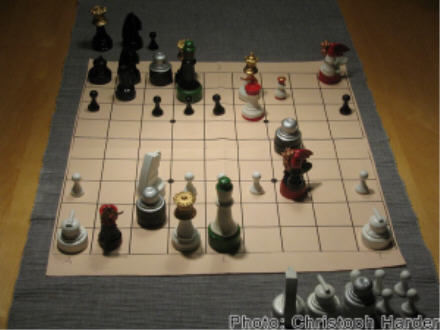
Transformation of the original Shogi-diagram into westernized optics: White is lost
(photo: Christoph Harder; design of figurine pieces: Dr. René Gralla).
I. If 27.Ke1-d2 ... (26. ... K4b), then: 27.... pr.Rb1xd1# (27.+Rx4a#) ;
II. if 27.Ke1-e2 ... (26. ... K5b), then: 27.... pr.Rb1xd1# (27.+Rx4a#) ;
III. if 27.Ke1-f1 ... (26. ... K6a) then: 27.... G-f2 drops # (G*6b#).
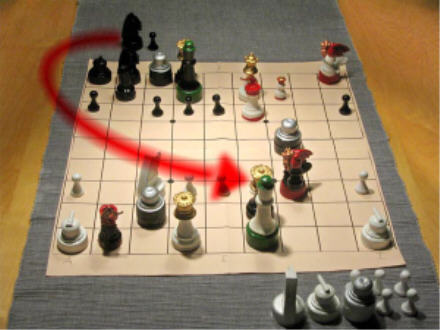
Black Gold General directly flies in to f2 (6b) and, by being backed up by Ishiyama's Dragon Horse on g3 (7c), check-mates White King on f1 (6a).
Photo: Christoph Harder; design of figurine pieces: Dr. René Gralla.
IV. Last try: 27.S-f2 drops ... (26. ... S*6b). No change: 27.... pr.Rb1xd1# (27.+Rx4a#).
Consequence:
27. Resigns (26.... resigns) 0:1
That dramatic duel does Garry Kasparov credit: The "Beast from Baku" - as frustrated victims use to curse him - has come ominously near to defeating 3 dan-Japanese Eiichiro Ishiyama.

Therefore, after Kasparov has been forced to give up his bid for the presidency, he can now pick up a third career - in Shogi. Since already in November 2008 there will be 4th Amateur World Championship of Shogi at Tendo, Japan.
If not the Kremlin, then the Realm of The Tenno: a real challenge for Super Garry.
Dr. René Gralla, Hamburg, Germany
Written by René Gralla. Web page made by Hans Bodlaender. Photo's by various creators.
Web page made: Februari 16, 2008.

